
Concrete finishing is a vital step in the construction process, giving surfaces their final appearance and Improving their durability. Achieving a perfect concrete finish requires skill, precision, and the right techniques. Whether you're working on a Concrete wall treatment, concrete floor finishes, or even an exposed concrete finish, following expert tips can help you achieve outstanding results. In this blog, we'll explore professional advice for perfecting your concrete finishing projects and provide a Q&A section to address common questions.
Concrete finishing involves various techniques and processes used to smooth, texture, or decorate the surface of concrete. The finishing process is crucial for improving the Stylish appeal and functional qualities of concrete surfaces. Here are some key types of concrete finishes:
Before you start the finishing process, ensure that the concrete surface is properly prepared. This involves:
Cleaning: Remove any dirt, debris, or old coatings from the surface.
Repairing: Fix any cracks or imperfections to create a smooth, even base.
Leveling: Ensure the concrete is level to avoid uneven finishes.
Selecting the appropriate tools and materials for your specific concrete finish is essential. Common tools include:
Trowels: Used for smoothing and leveling the surface.
Floats: Help to achieve a smooth finish by removing surface imperfections.
Brushes and Rollers: Used for applying concrete floor stain or other coatings.
Timing plays a crucial role in concrete finishing. It's important to start the finishing process at the right time when the concrete has set but is still workable. Here are some key timing tips:
Initial Set: Start the finishing process when the concrete begins to lose its sheen and becomes firm enough to support your weight without sinking.
Final Set: Complete the finishing process before the concrete fully hardens to ensure a smooth, even finish.
Different finishing techniques are required for various types of concrete finishes:
For Concrete Wall Finish
For Concrete Floor Finishes
For Exposed Concrete Finish
For Concrete Floor Stain
Proper curing and sealing are critical for achieving a durable and long-lasting concrete finish:
Achieving a perfect concrete finish requires careful preparation, the right tools and techniques, and proper timing. Whether you're working on a concrete wall finish, concrete floor finishes, or a Group reveal finish, following these expert tips can help you achieve professional-quality results. Remember to also consider the benefits of using concrete floor stain to add color and character to your concrete surfaces. By mastering these techniques, you can create beautiful, durable, and functional concrete finishes that stand the test of time.
1. What is the best technique for achieving an exposed concrete finish?
A: To achieve a Group reveal finish, start by applying a surface retarder immediately after placing the concrete. This delays the setting of the top layer. Once the concrete has partially set, wash away the surface layer using a pressure washer or hose and brush to reveal the Group beneath. Ensure even washing to maintain a consistent finish.
2. How can I ensure a smooth concrete wall finish?
A: For a smooth concrete wall finish, begin by screeding the surface to level it. Use a float to remove any imperfections and create a smooth base. Finally, use a trowel to polish the surface, working in a consistent pattern to avoid streaks or uneven areas.
3. What should I consider when applying concrete floor finishes?
Q: A: When applying concrete floor finishes, consider the following factors: proper timing (start when the concrete is firm but workable), use of appropriate tools (bull float, edger, trowel), and the desired finish (smooth, textured, or polished). Additionally, ensure proper curing and sealing to improve durability and appearance.
4. How do I apply concrete floor stain effectively?
A: To apply concrete floor stain effectively, start by thoroughly cleaning the surface to remove any contaminants. Apply the stain using a brush, roller, or sprayer, following the manufacturer's instructions. Allow the stain to penetrate and dry completely. Finish by applying a sealer to protect the stained surface and Improving its color.












